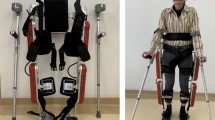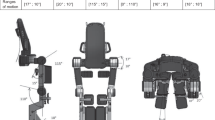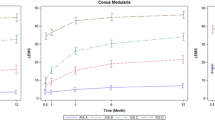Abstract
Study design
Prospective Comparative Study.
Objective
This study aims to compare the functional outcomes of Robotic-assisted rehabilitation by Lokomat system Vs. Conventional rehabilitation in participants with Dorsolumbar complete spinal cord injury (SCI).
Setting
University level teaching hospital in a hilly state of northern India.
Methods
15 participants with Dorsolumbar SCI with ASIA A neurology were allocated to robotic rehabilitation and 15 participants to conventional rehabilitation after an operative procedure. Pre-and Post-rehabilitation parameters were noted in terms of ASIA Neurology, Motor and sensory function scores, WISCI II score (Walking Index in SCI score), LEMS (Lower Extremity Motor Score), SCI M III score (Spinal Cord Independence Measure III score), AO Spine PROST (AO Patient Reported Outcome Spine Trauma), McGill QOL score (Mc Gill Quality of Life score), VAS score (Visual Analogue Scale) for pain and Modified Ashworth scale for spasticity in lower limbs.
Results
On comparing robotic group with conventional group there was a statistically significant improvement in Robotic-assisted rehabilitation group in terms of Motor score (p = 0.034), WISCI II score (p = 0.0001), SCIM III score (p = 0.0001), AO PROST score (p = 0.0001), Mc GILL QOL score (p = 0.0001), Max velocity (p = 0.0001) and Step length (p = 0.0001). Whereas LEMS score (p = 0.052), ASIA neurology (p = 0.264 (ASIA A); 1.000 (ASIA B); 0.053 (ASIA C)), VAS score (p = 0.099), Sensory score (p = 0.422) and Modified Ashworth scale for spasticity (p = 0.136) were not statically significant when comparing between two groups.
Conclusion
Robot-assisted rehabilitation is superior than conventional rehabilitation in people living with SCI with AIS A neurology. Differences in the patient group, type of a lesion its and severity, duration from onset to initiation of rehabilitation, devices employed, administration of the therapies and regulation of interventions are likely the cause of variations in the findings seen in the literature for robotic assisted training. Level of Evidence: III.
This is a preview of subscription content, access via your institution
Access options
Subscribe to this journal
Receive 12 print issues and online access
$259.00 per year
only $21.58 per issue
Buy this article
- Purchase on Springer Link
- Instant access to full article PDF
Prices may be subject to local taxes which are calculated during checkout



Similar content being viewed by others
Data availability
The datasets used and/or analysed during the current study are available from the corresponding author upon reasonable request. Data regarding this study is not available in any electronic databases.
References
Bishop L, Stein J, Wong CK. Robot-aided gait training in an individual with chronic spinal cord injury: a case study. J Neurol Phys Ther. 2012;36:138–43.
Ditunno PL, Patrick M, Stineman M, Ditunno JF. Who wants to walk? Preferences for recovery after SCI: a longitudinal and cross-sectional study. Spinal Cord. 2008;46:500–6.
van Asbeck F, Post M, Pangalila R. An epidemiological description of spinal cord injuries in The Netherlands in 1994. Spinal Cord. 2000;38:420–4.
Warren S, Moore M, Johnson MS. Traumatic head and spinal cord injuries in Alaska (1991-1993). Alsk Med. 1995;37:11–19.
Wyndaele M, Wyndaele J-J. Incidence, prevalence and epidemiology of spinal cord injury: what learns a worldwide literature survey? Spinal Cord. 2006;44:523–9.
Calabrò RS, Cacciola A, Bertè F, Manuli A, Leo A, Bramanti A, et al. Robotic gait rehabilitation and substitution devices in neurological disorders: where are we now? Neurol Sci. 2016;37:503–14.
Waters RL, Adkins RH, Yakura JS, Sie I. Motor and sensory recovery following incomplete paraplegia. Arch Phys Med Rehabil. 1994;75:67–72.
van Middendorp JJ, Hosman AJF, Pouw MH, Van de Meent H. ASIA impairment scale conversion in traumatic SCI: is it related with the ability to walk? A descriptive comparison with functional ambulation outcome measures in 273 patients. Spinal Cord. 2009;47:555–60.
Ditunno JF, Scivoletto G, Patrick M, Biering-Sorensen F, Abel R, Marino R. Validation of the walking index for spinal cord injury in a US and European clinical population. Spinal Cord. 2008;46:181–8.
Piepmeier JM, Jenkins NR. Late neurological changes following traumatic spinal cord injury. J Neurosurg. 1988;69:399–402.
Behrman AL, Bowden MG, Nair PM. Neuroplasticity after spinal cord injury and training: an emerging paradigm shift in rehabilitation and walking recovery. Phys Ther. 2006;86:1406–25.
Harness ET, Yozbatiran N, Cramer SC. Effects of intense exercise in chronic spinal cord injury. Spinal Cord. 2008;46:733–7.
van Hedel HJA, Dietz V. Rehabilitation of locomotion after spinal cord injury. Restor Neurol Neurosci. 2010;28:123–34.
Hubli M, Dietz V. The physiological basis of neurorehabilitation—locomotor training after spinal cord injury. J Neuroeng Rehabil. 2013;10:5.
Dietz V. Locomotor activity in spinal man: significance of afferent input from joint and load receptors. Brain. 2002;125:2626–34.
Edgerton VR, Leon RD, Harkema SJ, Hodgson JA, London N, Reinkensmeyer DJ, et al. Retraining the injured spinal cord. J Physiol. 2001;533:15–22.
Barbeau H, Nadeau S, Garneau C. Physical determinants, emerging concepts, and training approaches in gait of individuals with spinal cord injury. J Neurotrauma. 2006;23:571–85.
Winchester P, McColl R, Querry R, Foreman N, Mosby J, Tansey K, et al. Changes in supraspinal activation patterns following robotic locomotor therapy in motor-incomplete spinal cord injury. Neurorehabil Neural Repair. 2005;19:313–24.
Swinnen E, Duerinck S, Baeyens J, Meeusen R, Kerckhofs E. Effectiveness of robot-assisted gait training in persons with spinal cord injury: a systematic review. J Rehabil Med. 2010;42:520–6.
Freivogel S, Schmalohr D, Mehrholz J. Improved walking ability and reduced therapeutic stress with an electromechanical gait device. J Rehabil Med. 2009;41:734–9.
Alashram AR, Annino G, Padua E. Robot-assisted gait training in individuals with spinal cord injury: a systematic review for the clinical effectiveness of Lokomat. J Clin Neurosci. 2021;91:260–9.
Holanda LJ, Silva PMM, Amorim TC, Lacerda MO, Simão CR, Morya E. Robotic-assisted gait as a tool for rehabilitation of individuals with spinal cord injury: a systematic review. J Neuroeng Rehabil. 2017;14:126.
Piira AM, Lannem AM, Sørensen M, Glott T, Knutsen R, Jørgensen L, et al. Robot-assisted locomotor training did not improve walking function in patients with chronic incomplete spinal cord injury: a randomized clinical trial. J Rehabil Med. 2019;51:385–9.
Shin JC, Kim JY, Park HK, Kim NY. Effect of robotic-assisted gait training in patients with incomplete spinal cord injury. Ann Rehabil Med. 2014;38:719.
Khorasanizadeh M, Yousefifard M, Eskian M, Lu Y, Chalangari M, Harrop JS, et al. Neurological recovery following traumatic spinal cord injury: a systematic review and meta-analysis. J Neurosurg Spine. 2019;30:683–99.
Alcobendas-Maestro M, Esclarín-Ruz A, Casado-López RM, Muñoz-González A, Pérez-Mateos G, González-Valdizán E, et al. Lokomat robotic-assisted versus overground training within 3 to 6 months of incomplete spinal cord lesion: randomized controlled trial. Neurorehabil Neural Repair. 2012;26:1058–63.
Mıdık M. Effects of robot-assisted gait training on lower extremity strength, functional independence, and walking function in men with incomplete traumatic spinal cord injury. Turk J Phys Med Rehabil. 2020;66:54–59.
Yildirim MA, Öneş K, Gökşenoğlu G. Early term effects of robotic assisted gait training on ambulation and functional capacity in patients with spinal cord injury. Turk J Med Sci. 2019;49:838–43.
Benito-Penalva J, Edwards DJ, Opisso E, Cortes M, Lopez-Blazquez R, Murillo N, et al. Gait training in human spinal cord injury using electromechanical systems: effect of device type and patient characteristics. Arch Phys Med Rehabil. 2012;93:404–12.
Galen SS, Clarke CJ, Allan DB, Conway BA. A portable gait assessment tool to record temporal gait parameters in SCI. Med Eng Phys. 2011;33:626–32.
Schwartz I, Sajina A, Neeb M, Fisher I, Katz-Luerer M, Meiner Z. Locomotor training using a robotic device in patients with subacute spinal cord injury. Spinal Cord. 2011;49:1062–7.
Author information
Authors and Affiliations
Contributions
C.K.K.—Planning of study, Data management, outcome assessment, manuscript preparation. V.V.—Data management, outcome assessment. A.R.—Literature search, writing the manuscript. S.I.—Data management, outcome assessment. P.V.S.—Data management, outcome assessment. S.S.S.—Data management, outcome assessment. P.K.—Data management, outcome assessment, revising manuscript. B.S.—Planning of study, manuscript preparation.
Corresponding author
Ethics declarations
Competing interests
The authors declare no competing interests.
Ethical approval
All procedures performed in studies involving human participants were in accordance with the ethical standards of the institutional and/or national research committee.
Consent to partcipate
Consent taken with parents of each individual for the enrolment of study and publication of data on research paper. Subjects of Figs. 2, 3 have provided INFORMED WRITTEN CONSENT for their photos to be used in this paper & understand that they will be published online.
Additional information
Publisher’s note Springer Nature remains neutral with regard to jurisdictional claims in published maps and institutional affiliations.
Supplementary information
Rights and permissions
Springer Nature or its licensor (e.g. a society or other partner) holds exclusive rights to this article under a publishing agreement with the author(s) or other rightsholder(s); author self-archiving of the accepted manuscript version of this article is solely governed by the terms of such publishing agreement and applicable law.
About this article
Cite this article
Khande, C.K., Verma, V., Regmi, A. et al. Effect on functional outcome of robotic assisted rehabilitation versus conventional rehabilitation in patients with complete spinal cord injury: a prospective comparative study. Spinal Cord (2024). https://doi.org/10.1038/s41393-024-00970-1
Received:
Revised:
Accepted:
Published:
DOI: https://doi.org/10.1038/s41393-024-00970-1



